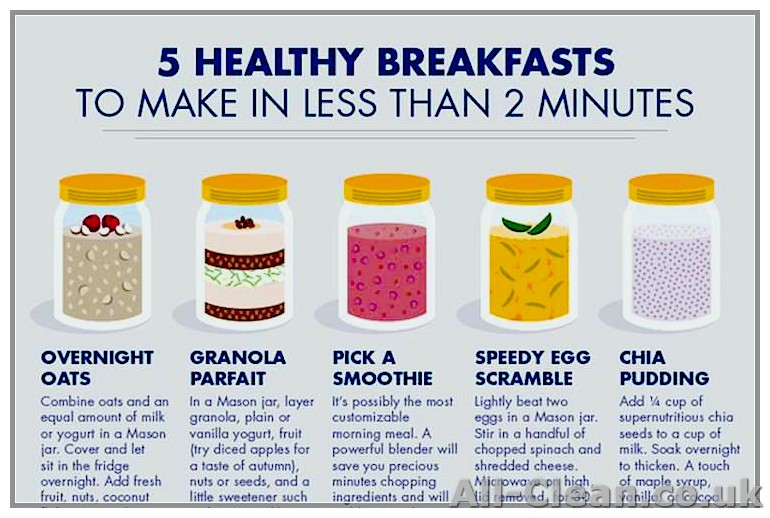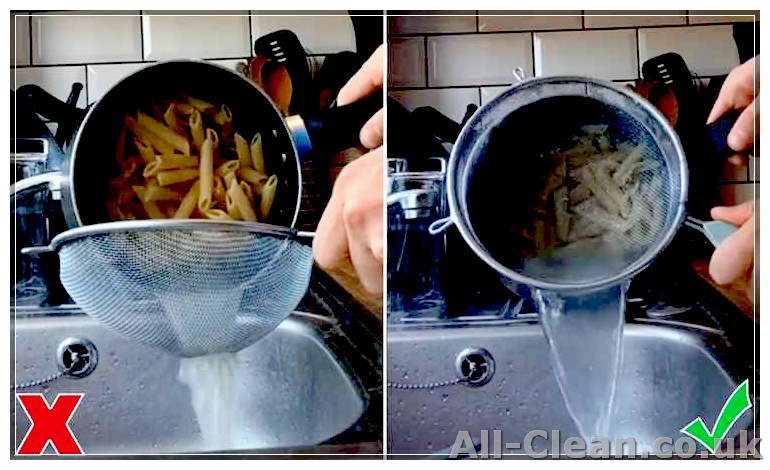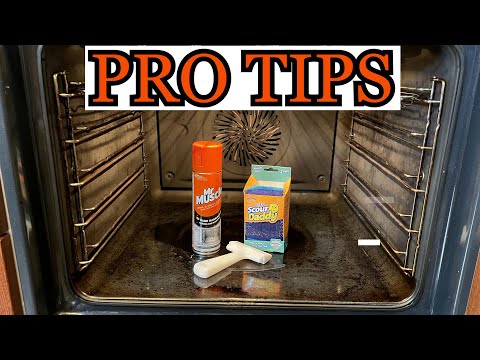
Are you tired of washing your sieve only to find that stubborn food particles are still lingering? Do you want a quick and easy solution to banish those pesky remnants from your favorite kitchen utensil? Look no further! The authors of this article have discovered a game-changing two-ingredient hack that will help you remove food residue from your sieve easily and without scrubbing.
When it comes to cleaning a sieve, many people often struggle with dislodging particles that get stuck in the small holes. However, with this simple trick, you can ensure that your sieve is fully clean and ready for use in no time.
So, what is the secret behind this game-changing hack? Well, the answer is surprisingly simple. All you need is some warm water and baking soda! Yes, that’s right, these two staple ingredients are all you need to give your sieve a thorough cleaning.
Here’s a step-by-step guide on how to properly clean your sieve using this handy trick:
- First, make sure you have a bowl or sink filled with warm water.
- Next, add a tablespoon of baking soda to the water and stir well until it dissolves.
- Submerge your sieve in the warm water and baking soda mixture, making sure it is fully covered.
- Leave the sieve to soak for at least 10 minutes. This will allow the baking soda to work its magic by loosening any stubborn particles.
- After 10 minutes, take a brush and gently scrub the sieve to remove any remaining residue.
- Rinse the sieve under running water to remove any excess baking soda and food particles.
- Finally, dry the sieve with a clean towel and place it in a well-ventilated area to ensure it is fully dry before use.
This game-changing hack is particularly useful for metal sieves, as it helps to prevent any burn marks or damage that may occur when using harsh cleaning chemicals or scrubbing too vigorously. Plus, the warm water and baking soda combination creates a powerful yet safe cleaning solution.
So, next time you find yourself struggling to clean your sieve, consider giving this two-ingredient hack a try. You’ll be amazed at how easy it is to banish stubborn food residue and have a clean sieve ready for your cooking adventures!
For more expert tips and resources on cleaning and related topics, be sure to read our other articles. Happy cleaning!
- Related articles
- How to properly clean your sieve
- How to banish stubborn food residue from your sieve
- Expert tips for cleaning kitchen utensils
- How to clean sieves and other kitchen equipment
- Trending
- Expert Tips:
- Related Articles:
- How To Clean A Sieve Correctly
- How to Clean A Sieve
- 1. Gather Your Equipment
- 2. Remove Food Residue
- 3. Soak the Sieve
- 4. Scrub the Sieve
- 5. Rinse and Dry
- 6. Pro Tips
- Washing Up
- Properly Cleaning Your Sieve
- Other Washing Up Tips
- Community QA
- 1. How do I remove stubborn food residue from my sieve?
- 2. Can I use this hack to clean other kitchen utensils?
- 3. Is it safe to use baking soda on metal utensils?
- 4. Is there any alternative to baking soda that I can use for cleaning?
- 5. Can I use this method to clean non-metal sieves?
Related articles
-
How to properly clean your sieve
If you want to make sure your sieve is clean and free from any lingering food residue, there are a few tips you need to keep in mind. First, give your sieve a thorough scrubbing immediately after use to prevent any food from drying out and becoming more difficult to remove. Submerge your sieve in a bowl of warm, soapy water and use a brush to scrub away any remaining residue. Rinse the sieve well and dry it properly before storing it away.
-
How to banish stubborn food residue from your sieve
If you’re dealing with stubborn food residue that is particularly difficult to remove, there is a game-changing two ingredient hack you can try. Start by boiling water in a pot or kettle. Once the water is boiling, carefully pour it over the sieve, making sure to fully submerge the sieve in the hot water. Let the sieve sit for a few minutes to loosen the residue, then use a brush or scrubbing pad to gently dislodge the remaining food particles. Rinse the sieve well and dry it properly before using or storing.
-
Expert tips for cleaning kitchen utensils

Cleaning kitchen utensils can sometimes be a nightmare, especially when dealing with stubborn food residues. To make the cleaning process easier, always soak your utensils in warm, soapy water immediately after use. This will help loosen any dried-on food particles and make them easier to remove. Use a brush or sponge to scrub away the residue, paying particular attention to any crevices or hard-to-reach areas. Rinse the utensils thoroughly and dry them properly before putting them away.
-
How to clean sieves and other kitchen equipment
Cleaning sieves and other kitchen equipment properly is essential to maintain their longevity and ensure they perform their best. When cleaning a sieve, start by rinsing it under warm water to remove any loose debris. Then, soak the sieve in warm, soapy water for at least 15 minutes to loosen any stubborn residue. Use a brush or sponge to scrub away the remaining food particles, paying close attention to the mesh or holes of the sieve. Rinse the sieve thoroughly and dry it well before storing.
Trending
When it comes to kitchen hacks, everyone loves a quick and easy solution to a common problem. The latest trending hack in the culinary community is a two-ingredient trick to easily remove stubborn food residue from your sieve. Say goodbye to scrubbing and struggling to clean your sieves, and hello to a hassle-free method that requires minimal resources.
So, what’s the secret? All you need is a towel and a bowl of warm water. This simple yet effective hack will give your sieve a thorough clean without much effort on your part.
To start, place your sieve in a bowl big enough to fully submerge it. Fill the bowl with warm water, making sure the sieve is entirely covered. Thanks to the warm water, any food residue stuck in the sieve will start to loosen up and become easier to remove.
While the sieve is soaking, consider giving it a gentle scrub with a brush or cloth to dislodge any stubborn residue. This step is particularly important for a more thorough clean.
If you have a metal sieve, you can also heat up the water by placing the bowl on a stovetop and boiling it. The heat will help to loosen the food particles, making the cleaning process even easier.
Once you’re done soaking and scrubbing, take the sieve out of the water and give it a rinse under running water to remove any remaining residue. Make sure to let it dry properly before storing it away.
Expert Tips:
- Use a towel to dry the sieve thoroughly. This will help to prevent any moisture from causing rust or other damage.
- If you don’t have a towel, you can use clothing or any absorbent material to dry your sieve.
- Don’t leave your sieve to dry with food residue still on it. It’s a recipe for a cleaning nightmare. Make sure to clean it well before drying.
With this trending two-ingredient hack, cleaning your sieve has never been easier. Give it a try and banish stubborn food residue from your kitchen utensils with ease.
Related Articles:
- How to Properly Clean and Care for Your Kitchen Equipment
- More Tips and Tricks for a Sparkling Clean Kitchen
- The Ultimate Guide to Washing Your Kitchen Utensils
So, if you’re in need of a game-changing solution to cleaning your sieve, give this trending two-ingredient hack a try. It’s easy, efficient, and will leave your sieve free from stubborn food residue.
How To Clean A Sieve Correctly
Cleaning a sieve can be a daunting task, especially when stubborn food residue lingers and refuses to come off. But fear not! With the right technique and a couple of ingredients, you can easily banish the dirt and grime from your sieve.
To clean your sieve properly, follow these simple steps:
- Tap off any excess residue: Start by tapping the sieve gently against a towel or hard surface to remove any loose particles.
- Place the sieve under running water: Run warm water over the sieve to wash away any remaining residue. It’s recommended to do this immediately after use to prevent the food from hardening and becoming more difficult to remove.
- Boiling water method: For metal sieves, you can create a boiling water bath to help dislodge stubborn particles. Simply place the sieve in a pot of boiling water for a few minutes, making sure not to burn yourself. The hot water will help loosen the food residue, making it easier to clean.
- Use a brush or utensil: Once your sieve has been submerged in boiling water or rinsed under running water, use a brush or utensil to gently scrub away any remaining residue. Be sure to pay attention to the corners and edges where food tends to get trapped.
- Soap or baking soda: Depending on the material of your sieve, you can use a small amount of dish soap or baking soda to create a cleaning paste. Apply the paste to a brush or sponge and scrub the sieve thoroughly, paying special attention to any areas with stubborn residue.
- Rinse well: After scrubbing, rinse the sieve well under running water to remove any soap or baking soda residue. This step is important to ensure that no cleaning agents are left behind that could contaminate your food in the future.
- Dry properly: Finally, make sure to dry your sieve completely before storing it away. Leaving it wet can create a breeding ground for bacteria and may lead to rust in metal sieves. Use a clean towel or air-dry the sieve in a well-ventilated area.
By following these easy steps, you can keep your sieve clean and free from any lingering food residue. Say goodbye to the nightmare of scrubbing and enjoy a sparkling clean sieve!
How to Clean A Sieve
Cleaning a sieve correctly is essential to maintain its functionality and ensure hygienic food preparation. Whether you’re using a metal or a plastic sieve, this article will provide you with the necessary steps and tips to effectively clean your sieves.
1. Gather Your Equipment
Before you begin cleaning your sieve, make sure you have the following items at hand:
- Warm water
- Dish soap or baking soda
- A soft brush or sponge
- A towel or drying rack
2. Remove Food Residue
Start by tapping or shaking the sieve over a trash bin to remove any loose food particles.
If there is stubborn residue that doesn’t come off easily, you can use the game-changing two-ingredient hack mentioned in the related article. Mixing dish soap or baking soda with warm water can give the cleaning solution that effectively removes stuck-on food.
3. Soak the Sieve
Place the sieve in a bowl or sink filled with warm water mixed with dish soap or baking soda. Make sure the sieve is fully submerged.
Let it soak for at least 15 minutes to loosen any remaining residue.
4. Scrub the Sieve
Using a soft brush or sponge, scrub the sieve to remove any remaining food particles. Pay special attention to the mesh or holes to ensure a thorough clean.
For metal sieves, be cautious not to scrub too vigorously to avoid damaging or scratching the material.
5. Rinse and Dry
Once you’ve finished scrubbing, rinse the sieve under running water to remove any soap or baking soda residue.
Shake off the excess water and pat the sieve dry with a clean towel. Alternatively, place it on a drying rack to air dry.
6. Pro Tips
- Consider using a dedicated sieve brush, specifically designed for cleaning sieves.
- To banish any lingering odors, soak the sieve in a solution of warm water and vinegar.
- If you use your sieve frequently, it’s a good idea to clean it after each use to prevent food buildup.
Cleaning a sieve can be an easy and quick task when done properly. Following these steps will help you keep your sieves clean and in top condition for your cooking and baking needs. Thanks for reading!
Washing Up
Washing up can be a chore that many people dread. Whether it’s scrubbing dishes, cleaning utensils, or tackling stubborn food residue, it’s a task that needs to be done. But with the right tools and techniques, washing up can be made much easier and more efficient.
Properly Cleaning Your Sieve
When it comes to cleaning sieves, many people struggle to remove all the lingering food particles. This is especially true for sieves used to strain pasta or rice, as the starchy residue can be difficult to dislodge. But don’t worry, we have a game-changing two ingredient hack that will banish those stubborn food residues.
To clean your sieve properly, you will need:
- A bowl or sink with warm water
- Baking soda
First, make sure your sieve is fully dry and free from any clothing or related material. Then, submerge the sieve in warm water to soften the residues. After a few minutes, sprinkle some baking soda over the sieve and use a brush to scrub away the stubborn particles. The baking soda will act as a gentle abrasive, effectively removing the residue without scratching or damaging the metal.
Once you have scrubbed away all the residue, rinse the sieve thoroughly under running water to remove any remaining baking soda. Make sure the sieve is completely clean and dry before storing it away.
Other Washing Up Tips

While cleaning your sieve is important, there are many other tools and utensils that also need proper cleaning. Here are some additional tips to keep in mind:
- Always wash up immediately after use to prevent food residues from drying and becoming more difficult to remove.
- Use hot water when washing up, as it will help to loosen grease and make cleaning easier.
- If you have burnt-on food or stains, try soaking the utensil in hot, soapy water for a few minutes. This will help to soften the residues and make them easier to scrub away.
- For equipment that cannot be submerged in water, use a damp cloth or sponge to wipe away any food residues.
- Don’t forget to clean your dishcloths and sponges regularly to prevent the buildup of bacteria.
By following these washing up tips and using our game-changing two ingredient hack for cleaning stubborn food residues from your sieve, washing up can be made a much easier and more efficient task. So next time you’re faced with a sink full of dirty dishes, you’ll know exactly how to tackle them without any fuss.
Community QA
1. How do I remove stubborn food residue from my sieve?
Removing stubborn food residue from a sieve can be a challenging task, but with the right technique, it can be done easily. Follow these steps to remove lingering food particles from your sieve:
- Start by tapping the sieve to remove any dry food particles that may come off easily.
- If the residue is more stubborn, try using a non-abrasive brush to scrub the sieve under warm running water.
- If the previous step doesn’t work, a two-ingredient hack can come to your rescue: boil water in a large pot and add a tablespoon of baking soda. Carefully submerge the sieve into the boiling water and let it soak for at least 15 minutes.
- After soaking, remove the sieve from the pot and rinse it thoroughly under warm running water to remove any residue or soap.
- Make sure to dry the sieve completely before using it again.
2. Can I use this hack to clean other kitchen utensils?
Yes, this hack can also be used to clean other kitchen utensils, particularly those made of metal. Just make sure the material is safe for boiling water and doesn’t have any delicate parts that may be damaged by heat or the cleaning process.
3. Is it safe to use baking soda on metal utensils?
Yes, baking soda is safe to use on metal utensils. It is known for its gentle abrasive properties, which can help dislodge stubborn residue without scratching the surface of the utensil.
4. Is there any alternative to baking soda that I can use for cleaning?
If you don’t have baking soda on hand, you can try using a small amount of dish soap mixed with warm water. This solution can also be effective in removing stubborn food residue from your sieve or other utensils.
5. Can I use this method to clean non-metal sieves?
While this method can be effective for cleaning metal sieves, it may not be suitable for non-metal sieves or sieves made of delicate materials. In such cases, it’s best to refer to the manufacturer’s instructions or seek alternative cleaning methods.








